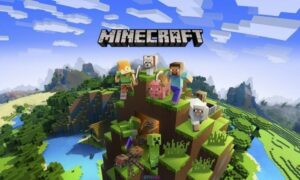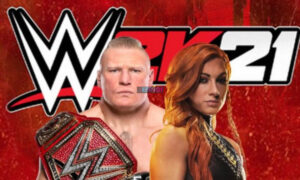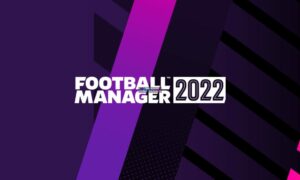A character-based Multiplayer Game Overwatch Detailed Review
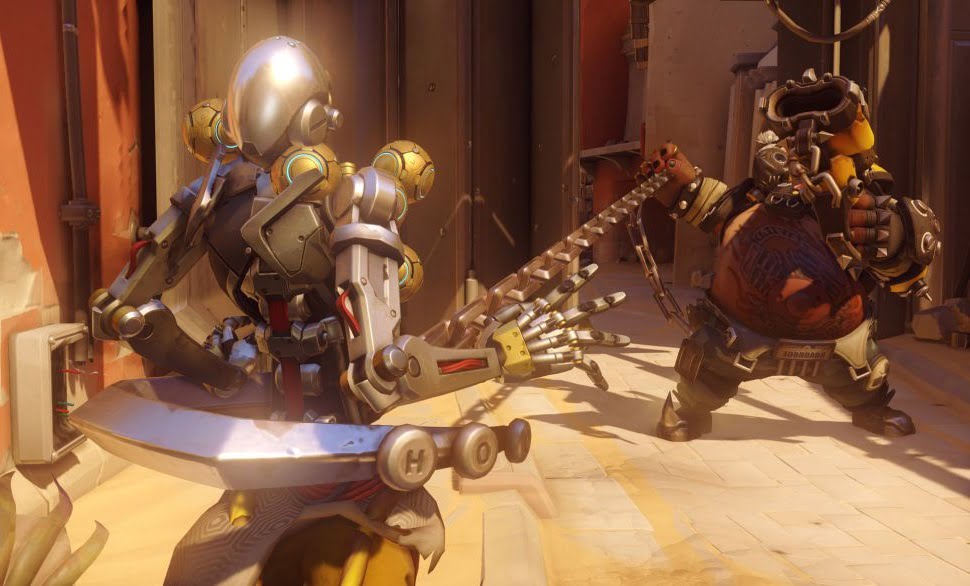
What is it: A character-based multiplayer first-person shooter set on a futuristic Earth that features robots and a cowboy.
Reviewed on: Windows 10, 8GB RAM, i5-3570k, GeForce GTX 970
Price: £30/$40
Release date: Out now
Publisher: Blizzard
Developer: Blizzard
Multiplayer: 6-vs-6
Right now, I hate Junkrat. He’s a scrawny, impish explosives expert with a grenade lobbing Frag Launcher. His ultimate ability – a slow charging special attack that fills faster as you do damage and score kills – is a motorized, remote control tire bomb with a devastating area of effect. Put simply, he makes things blow up. Things like me and my team of disparate misfits, who, until Junkrat showed up, were seconds away from successfully defending the control point and winning the match.
That’s Overwatch, a multiplayer character-based shooter in which 12 players compete across two teams to fulfill whatever objective the map asks of them. I say character-based rather than class-based, and that’s an important distinction. Widowmaker and Hanzo are both snipers, but play completely differently. Mercy and Lucio are both healers, but one uses a staff that shoots healing energy, and the other, well, phat beats. Each character fits into a broader category, but is otherwise unique. Weapons, abilities, ultimates and even movement are all specific to that hero.
It’s a shooter then, but with a MOBA attitude to character design. To be clear: Overwatch isn’t a MOBA. Rather, it’s like if Heroes of the Storm went to Team Fortress 2’s house party, and left without cleaning up after itself. There’s no lane-pushing, AI creeps, item shopping or leveling. Objectives are straight out of the class-based shooter playbook, with points to attack and defend, payloads to push and hills to king. But characters have abilities, each reflective of their style and personality. And those abilities have cooldown timers, each different depending on their power and utility.
Take Tracer, the peppy attack hero with the grating faux-cockney accent. Her basic ability, Blink, is a short-range teleport that holds three charges, each on a three-second cooldown. Her more powerful move, Recall, rewinds her to the health, ammo, and position she was three seconds before. It’s perfect for extricating yourself from a dangerous fight but takes 12 seconds to recharge.
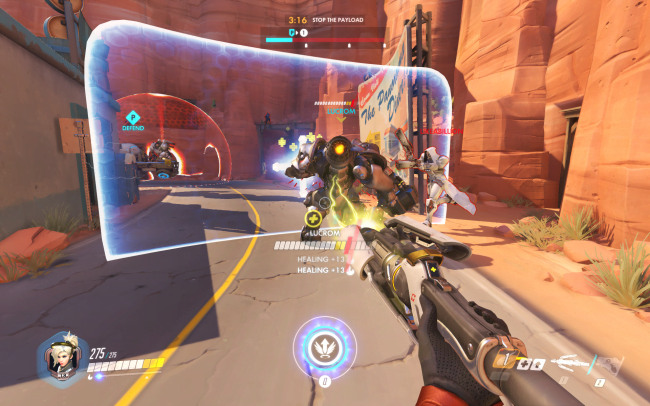
There are characters who improve map visibility, soak up incoming damage with shields, or throw out armor for teammates to pick up. There are characters who lay traps, or debuff or stun enemies. There are characters who use a jetpack, teleport long distances, or boost movement speed for every teammate within an area of effect. It’s a wide and varied roster with a plethora of styles and abilities.
Balancing that, some systems are more streamlined than you’d expect from a class-based shooter. Only a couple of heroes carry multiple weapons, but even that is mostly a choice between attack and utility. Only some heroes have an alternate fire mode. Even beyond specific load-outs, there’s no ammo management. Most guns need to be reloaded, but they have an unlimited ammo pool to draw upon. There’s still plenty of complexity, though, and, by using abilities, Overwatch feels distinct from its competitors.
I particularly love how varied the movement is between characters. Not just Tracer’s Blink, but also Genji’s vertical scaling, Lucio’s wallrun, Widowmaker’s grappling hook and, most of all, Mercy’s glide. Mercy, Overwatch’s medic, is the perfect example of how every aspect of a character can, in the best cases, support a specific style. Alone, she’s vulnerable and slow – easily ambushed and dispatched. But, with line-of-sight to a teammate, she can spread her wings and fly towards them. It’s fun to do, and also reinforces the symbiotic partnership between healer and healed: Mercy needs her teammates as much as they need her. It’s a masterful design.
Part of the process of playing Overwatch is learning the characters, their abilities and how to counter them. This can be both gratifying and infuriating – hence why I currently hate Junkrat. Previously, I’ve hated the sentient turret Bastion, the assault rifle-wielding Soldier: 76, the sniper Widowmaker, the engineer Torbjörn, and, briefly, the shuriken throwing Genji. Tomorrow, I’ll likely hate someone else. It’s a work in progress list, which changes with each new revelation over how to identify, avoid and eventually nullify a particular style of play.
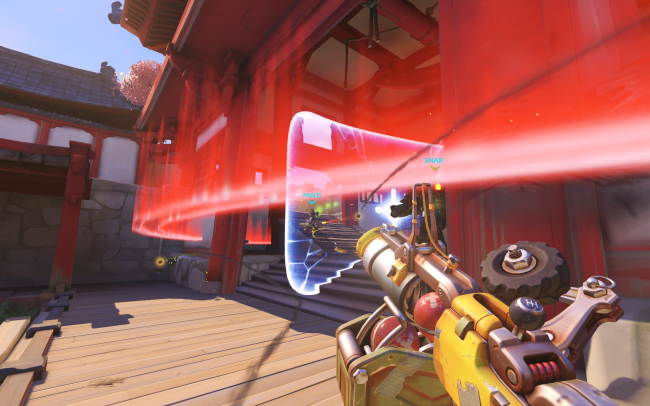
Many times, I’ve been annoyed by a specific attack or ability. I have decried things as being OP, or, worse, as hot bullshit. But balance is a nebulous thing in a shooter that lets you change character mid-match; that lets a team field multiple instances of the same character. It rarely is bullshit, but rather my own frustration at my inability to anticipate the thing that killed me. And there are many, many characters I adore. Mercy, clearly, alongside fellow support Lucio, with his beat dropping ultimate that briefly overcharges the shields of nearby teammates. Also Tracer, and Pudge-a-like chain hook carrier Roadhog. And yes, even Junkrat. Sometimes it’s fun to be the jerk.
Not all the characters work, though, and not just because I’m bad at them. Bastion is already infamous among the Overwatch community, reviled for being cheap, powerful and a little bit boring. He’s a robot that can transform into a high powered, long-range, highly accurate turret. He’s the bane of new players everywhere. I’m now at a point where Bastion rarely bothers me, but he still feels out of place. He’s rarely fun to play and almost never fun to fight. He’s an annoyance – either trivial or devastating depending on your experience and ability to work as a team. That’s because, despite some heroes clearly being more friendly to beginners, Overwatch values and rewards experience and skill. That’s great for the most part, but leaves characters like Bastion in an awkward place.
Support our troops
With so many heroes to choose from, and only six players per team, composition is vital. Again, experience comes into play here, and after a few hours, you’ll get a feel for some effective combinations. The interface does a good job of cajoling players into making sound picks. During the opening seconds of a match, the entire team sits at the character selection screen, picking heroes while a tooltip critiques the overabundance of snipers or lack of support. It works more often than it doesn’t – I’ve seen players guiltily snap up their favorite pick before grudgingly switching to a tanking character for the good of the team. Still, sometimes you’re going to end up on defense with two Hanzos and a Widowmaker. No tooltip can fully eradicate human stubbornness. Luckily, such matches tend to be short.
The end of the match “Play of the Game” clip doesn’t exactly help. As the name suggests, it caps things off with a brief clip showing the most impressive action of that round from the perspective of the player. Right now, the algorithm seems to favor multi-kills, thus a specific roster of heroes. You’ll see Bastion mow down a string of helpless attackers. You’ll see Torbjörn hammering away at his turret. You’ll see Junkrat’s tire bomb blow up half a team. Sometimes, rarely, you’ll see a supporting character do something helpful. I suspect that only happens when nobody achieves a big enough killstreak.
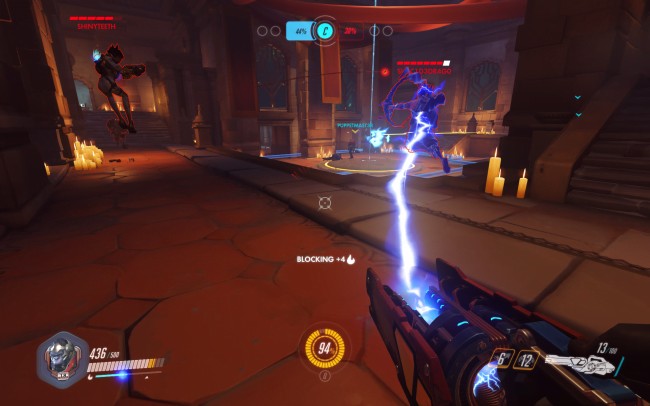
While individual characters each have a couple of hard counters, things become more complicated across an entire team. Bastion, when operating as a sole agent, is easy enough to deal with. But a Bastion protected by Reinhart’s energy shield is a powerful combination, especially if both are supported by Torbjörn’s upgraded turret. In Overwatch, communication is just as important as experience. It feels like there are specific hero combinations that – in pub play, without the cohesion that comes from fighting with friends – can be extremely difficult to unpick.
A lot of that is down to the maps, and the few, specific locations where things become slightly too restrictive. For the most part, the maps are great – an interesting flow of chokepoints, corridors, open areas, and alternate routes. The best maps give specific pathways for each type of hero – be it a wide main corridor for the lumbering tanks, narrow flanking routes for the squishy attackers, or balconies for those heroes that can climb, clamber and fly. But then, in certain areas, that doesn’t hold true. One of my most frustrating matches took place in the hanger of Watchpoint: Gibraltar, where turrets and tank heroes easily repelled our attempts to get close. A failure of communication on our part, sure, but also a casualty of us having fewer routes to the enemy’s position.
Escort mode maps – think TF2’s payload mode – are, to my mind, the weaker set. I feel less constrained by the maps designed for point capture modes. More than that, though, Overwatch feels more urgent and interesting when these small, varied teams are battling over a static, vulnerable control point. The most exciting and tense moments I’ve yet had in Overwatch have been at Hanamura’s final, multilayered temple, and the open indoor arena of Volskaya Industries. These were the stages for wonderfully close encounters, where the winner only emerged at the last possible second.
To help solo queuers communicate, a dialogue wheel lets you call out important information. Stuff like: get on that objective, group up with me, or, most frequently heard of all, hello. That said, it is one of the weaker interface elements – the icons and messages often getting lost in the audiovisual assault that is moment-to-moment play.
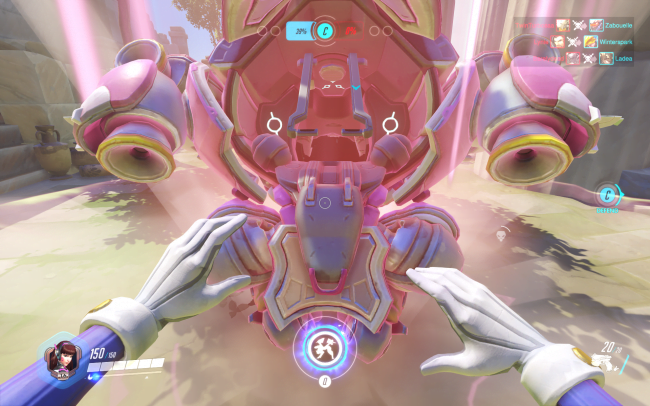
Despite being set in a future version of our own world, Overwatch still looks and feels like a Blizzard game. It’s bright, vibrant and quirky – its characters a mixture of lovable rogues, gruff villains and over the top heroes. It’s disparate and strange. A team might feature an erudite gorilla, a blue assassin, a meditating robot, a cowboy, a cyborg ninja, and a teenage Starcraft pro in a pink mech. It’s a diverse cast, and yet one that feels cohesive within the hyper exaggerated, cartoonish setting. It’s all tied to a story about futuristic terrorism, robot uprisings and a disbanded group of heroes. For the most part, this tale is told externally, through comics and short films. It feels incidental to the action. There is an opening cutscene, but I skipped it.
In action, Overwatch looks exhilarating. Matches are a light show of effects, as weapons fire and abilities trigger. Expect the first few hours to be overwhelming, as you learn what each effect means and why it just killed you. Eventually, as you start to parse the information behind the effects, it feels surprisingly clean. The small, incidental detail is fantastic, too, from the destructible objects in the spawn rooms to the way the cap of Junkrat’s Frag Launcher flaps open and closed as you jump. This is the sort of polish and attention you expect from Blizzard, and it’s great to see carried across into a first-person setting.
It also sounds amazing. If anything, the audio design conveys more information than the visuals. Each character has its own specific lines for the majority of interactions, keeping you abreast of the current situation. Enemy barks are more prominent in the mix, which alerts you to potential danger. The battle between clarity and style has one side effect: there’s a lot of repetition. Yes, Tracer, I do get that feeling of deja vu. Thanks for asking.
Weapons, for the most part, feel-good: big, powerful heroes shooting big, powerful guns. Roadhog’s chunky scrap gun is excellent, as are Reaper’s dual shotguns. Not all are that strong. Beam weapons and assault rifles are both a little underwhelming. The same holds true of abilities and ultimates – some are just more enjoyable to use. Others, however, have grown on me. I was initially disappointed by Lucio’s ultimate. It’s a beat drop, and could do with feeling more impactful. The subtler effect has since grown on me, but I had to meet it halfway.
Overwatch runs beautifully. Its options are highly customizable, and I’m yet to experience any frame rate drops playing on Ultra settings, on a 1920×1200 monitor with a GTX 970. As for online performance, the only lag I’ve experienced was isolated to a few hours on a single evening – probably more the fault of my sluggish home connection than Blizzard’s servers. And despite some predictable post-release downtime, servers have remained steady across launch week. It’s nice to have a new multiplayer game to perform so reliably.
If there’s a notable omission, it’s the lack of ranked matchmaking – planned for a late June release. Other team-based shooters get away with the lack of a ranked mode through the use of a server browser. In that setting, it’s easy to track down like-minded communities with their own tracking and sense of competition. Twelve players per match is likely too few to support a browser system, and so the current absence of a ranked system is more keenly felt. Overwatch does at least do a good job of making its action feel immediate and important, even when it’s not. A ranked system can only help to increase the stakes.
Currently, matchmaking can feel a bit wonky at times. Select a quickplay match and you’re placed into a queue to be matched with a group that the underlying maths has judged to be your equals. That doesn’t always feel like it’s the case – although it’s a hard thing to judge in an online game. Maybe that player who ran endlessly into a stream of Bastion turret fire was dealing with a cat on their keyboard. It happens.
In most games, frustration and annoyance are solid indicators that something isn’t working. Here, they’re part and parcel of competition. If I’m annoyed, someone else is having a good time. If I’m elated, someone else is raging. That can be difficult to put a score to because it removes emotion as the guiding light of a subjective process. Here’s what I can say for certain: Overwatch is a great, occasionally fantastic shooter, and filled with fresh, clever design decisions.
As good as it is, there are some rough patches to be found underneath Blizzard’s peerless polish. For that reason, Team Fortress 2 remains my favorite class-based shooter. Its characters feel more intricately woven, with a wider range of utility. Overwatch, however, comes in a pretty close second, and with the benefit of not carrying years of experimental baggage. Its microtransactions are better, too, thanks to them being purely cosmetic. Of course, that’s likely in part to the fact the game isn’t free to begin with.
Crucially, though, unless Blizzard does something drastically wrong, Overwatch is only going to get better. It’ll need new maps eventually, preferably before the current 12 get stale, and there are plenty of tweaks and alterations that it could benefit from. Whatever happens in the future, what Overwatch offers right now is an excellent start.
What types of games do you offer for download?
We offer a wide variety of games catering to different preferences and platforms. You can find everything from action-packed shooters and immersive RPGs to casual puzzles and indie gems. Our library includes games for PCs, consoles, and mobile devices.
Are the downloads free, or do I have to pay?
We offer free games. Some titles are available for free download.
Is it safe to download games from your website?
Yes, absolutely. We prioritize the safety and security of our users. All games available for download on our website undergo thorough screening for malware and viruses. Additionally, we partner with trusted developers and publishers to ensure that our users have a safe gaming experience.
How do I download games from your website?
Downloading games from our website is simple. Just browse through our library, select the game you want, and click on the download button. Follow the on-screen instructions to complete the download process. Depending on the size of the game and your internet speed, it may take some time to download.
Are there any age restrictions for downloading games?
Yes, some games may have age restrictions due to their content. We adhere to age ratings provided by official rating boards such as the ESRB, PEGI, and others. Make sure to check the age rating of each game before downloading to ensure it's suitable for your age group.
Can I share downloaded games with friends or family?
Sharing downloaded games with others may violate copyright laws and licensing agreements. We encourage our users to respect intellectual property rights and refrain from unauthorized distribution of downloaded games. If your friends or family members are interested in a particular game, encourage them to download it legally from our website.





